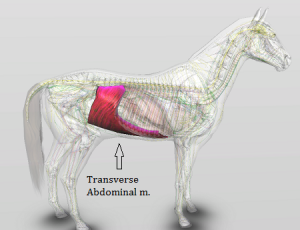NAME: Transverse Abdominal
ORIGIN: Transverse processes of the lumbar vertebrae
INSERTION: Xiphoid Cartilage
ACTION: Compress abdomen
OTHER INFORMATION: This large muscle overlaps two other major muscles that also support the horse’s topline: the external abdominal oblique and the internal abdominal oblique. When working on this muscle you are also affecting the others. We will look at these further on another blog post.
Doing ‘cookie tests’ and belly lifts will help determine how well this muscle is functioning in your horse. Not sure what those are? I will explain below.
If your horse is lacking topline, this is one of the muscles that needs to be strengthened. Polework, cavelleti, and hillwork will be your best friends for that! Don’t forget to check your saddle fit or have someone qualified to check it for you – an ill-fitting saddle or incorrect cinching can damage this muscle (as well as the other abdominal muscles).
To perform a cookie test, stand to one side and have your horse reach around with their head as you hold a cookie just out of reach – ideally, a horse should be able to reach around to their hipbone area without difficulty. If they cannot reach that far, or can only do so by tilting their head and twisting their neck, or just want to move their feet to get the treat, the transverse or other abdominal muscles may need to be addressed. Do both sides and see if one is better than another (likely there will be a ‘worse’ side).
To perform a belly lift, use your fingers or a blunt object and run them down the midline of your horse’s belly. A normal reaction will be for them to ‘suck’ in their belly muscles and lift up their back noticeably. If there is no such reaction, or you get an overreaction (an irritated horse, pinned ears, tail swishing, moving etc), then you know there may need to be some work in this area. If an irritated response is consistent with your horse, please consult the help of a certified therapist or vet who can help identify the source of pain.
It is common for stallions to not have much of a belly lift response.




